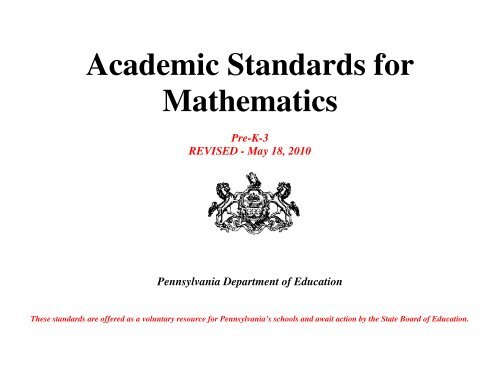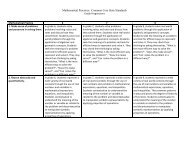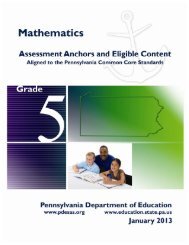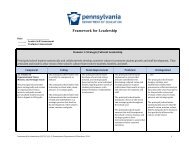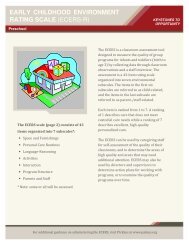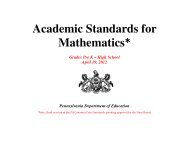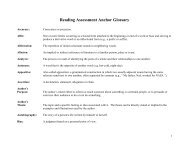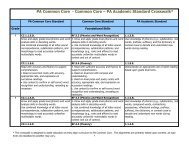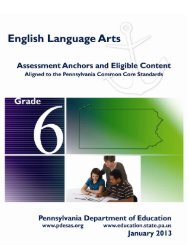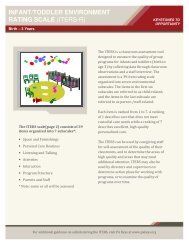Academic Standards for Mathematics (Primary) - SAS
Academic Standards for Mathematics (Primary) - SAS
Academic Standards for Mathematics (Primary) - SAS
Create successful ePaper yourself
Turn your PDF publications into a flip-book with our unique Google optimized e-Paper software.
<strong>Academic</strong> <strong>Standards</strong> <strong>for</strong><strong>Mathematics</strong>Pre-K-3REVISED - May 18, 2010Pennsylvania Department of EducationThese standards are offered as a voluntary resource <strong>for</strong> Pennsylvania’s schools and await action by the State Board of Education.
ELEMENTARY STANDARDSGrades Pre-K-3<strong>Mathematics</strong>V. INTRODUCTIONThis document includes <strong>Mathematics</strong> <strong>Standards</strong>:◊ 2.1. Numbers, Number Systems, and Number Relationships◊ 2.2. Computation and Estimation◊ 2.3. Measurement and Estimation◊ 2.4. Mathematical Reasoning and Connections◊ 2.5. Mathematical Problem Solving and Communication◊ 2.6. Statistics and Data Analysis◊ 2.7. Probability and Predictions◊ 2.8. Algebra and Functions◊ 2.9. Geometry◊ 2.10. Trigonometry◊ 2.11. Concepts of CalculusThe <strong>Mathematics</strong> <strong>Standards</strong> describe what students should know and be able to do at grade levels. They reflect the increasing complexity andsophistication that students are expected to achieve as they progress through school.With each standard divided into conceptual strands, this document avoids repetition of learned skills and makes an obvious progression across gradelevels less explicit. Teachers shall expect that students know and can apply the concepts and skills expressed at the preceding level. Consequently,previous learning is rein<strong>for</strong>ced but not re-taught.Students who achieve these mathematical standards will be able to communicate mathematically. Although it is an interesting and enjoyable study<strong>for</strong> its own sake, mathematics is most appropriately used as a tool to help organize and understand in<strong>for</strong>mation from other academic disciplines.Because our capacity to deal with all things mathematical is changing rapidly, students must be able to bring the most modern and effectivetechnology to bear on their learning of mathematical concepts and skills.A glossary is included to assist the reader in understanding terminology contained in the standards. Words in bold faced text are included in theglossary.Draft 5/18/103
ELEMENTARY STANDARDSGrades Pre-K-3<strong>Mathematics</strong>2.1. Numbers, Number Systems and Number Relationships2.1.PK. GRADE Pre-K 2.1.K. GRADE K 2.1.1. GRADE 1 2.1.2. GRADE 2 2.1.3. GRADE 3Pennsylvania’s public schools shall teach, challenge and support every student to realize his or her maximum potential and to acquire theknowledge and skills needed to:Count andCompare NumbersRepresentNumbers inEquivalent Forms2.1.PK.A.Demonstrate the relationshipbetween numbers andquantities, including rotecounting, one-to-onecorrespondence up to 10objects, and comparingvalues of whole numbers upto 10.2.1.PK.B.Represent equivalent <strong>for</strong>msof the same number throughthe use of pictures andconcrete objects up to 10.2.1.K.A.Demonstrate the relationshipbetween numbers andquantities, including rotecounting, one-to-onecorrespondence, andcounting by tens, andcomparing values of wholenumbers up to 20.2.1.K.B.Represent equivalent <strong>for</strong>msof the same number throughthe use of pictures andconcrete objects (includingpenny, nickel, and dime), upto 20.2.1.1.A.Demonstrate the relationshipbetween numbers andquantities, including placevalue, one-to-onecorrespondence, rotecounting, counting by twosto 20, counting by tens andfives, and comparing valuesof whole numbers up to 100.2.1.1.B.Represent equivalent <strong>for</strong>msof the same number throughthe use of pictures andconcrete objects (includingpenny, nickel, dime, andquarter), up to 100.2.1.2.A.Demonstrate the relationshipbetween numbers andquantities, including placevalue; one-to-onecorrespondence; rotecounting; counting by twos,fives and tens; andcomparing values of wholenumbers up to 500.2.1.2.B.Represent equivalent <strong>for</strong>msof the same number throughthe use of pictures andconcrete objects (includingpenny, nickel, dime, quarter,and dollar), up to 500.2.1.3.A.Apply one-to-onecorrespondence andnumber patterns to count upand count back and tocompare values of wholenumbers and values ofmoney.2.1.3.B.Represent equivalent <strong>for</strong>msof the same number throughthe use of concrete objects,drawings, word names, andsymbols.Concepts of Numbersand Relationships2.1.PK.C.Use concrete objects,drawings, diagrams ormodels to combine, separateand name groups of objects.2.1.K.C.Use concrete objects,drawings, diagrams ormodels to group objects intosets of ten; separate objectsinto equal parts.2.1.1.C.Use concrete objects,drawings, diagrams ormodels to show the conceptof a fraction as part of awhole; use whole numbersand fractions (halves andfourths) to representquantities.2.1.2.C.Use drawings or models toshow the concept of afraction as part of a whole;use whole numbers andsimple fractions (halves,thirds, and fourths) torepresent quantities.2.1.3.C.Use drawings, diagrams ormodels to show the conceptof fraction as part of awhole.Draft 5/18/102
ELEMENTARY STANDARDSGrades Pre-K-3<strong>Mathematics</strong>2.1. Numbers, Number Systems and Number Relationships2.1.PK. GRADE Pre-K 2.1.K. GRADE K 2.1.1. GRADE 1 2.1.2. GRADE 2 2.1.3. GRADE 3Pennsylvania’s public schools shall teach, challenge and support every student to realize his or her maximum potential and to acquire theknowledge and skills needed to:PlaceValueIntentionally Blank2.1.K.D.Use concrete objects todemonstrate regrouping onesto tens, with adultassistance.2.1.1.D.Apply place value conceptsand base-ten numeration toorder and compare wholenumbers up to 100.2.1.2.D.Apply place value conceptsand base-ten numeration toorder and compare wholenumbers up to 500.2.1.3.D.Apply place value conceptsand base-ten numeration toorder and compare wholenumbers.NumberTheoryIntentionally Blank2.1.K.E.Recognize even and oddnumber patterns.2.1.1.E.Describe even and oddnumbers as they relate to anumber pattern.2.1.2.E.Apply number patterns torepresent numbers in variousways (skip counting ,repeatedaddition/subtraction).2.1.3.E.Apply number patternseven and odd, factors andmultiples to representnumbers in various ways.Concepts andApplications ofOperations2.1.PK.F.Solve oral word problemsusing concrete objects, withteacher assistance.2.1.K.F.Use concrete objects tosolve addition andsubtraction word problems.2.1.1.F.Select the appropriateoperation (addition orsubtraction) to solveproblems.2.1.2.F.Use the inverserelationships betweenaddition and subtraction todetermine unknownquantities to solve problems.2.1.3.F.Understand the concepts ofaddition and subtraction anduse the inverse relationshipsbetween addition andsubtraction to determineunknown quantities inequations.Draft 5/18/103
ELEMENTARY STANDARDSGrades Pre-K-3<strong>Mathematics</strong>2.2. Computation and Estimation2.2.PK. Grade Pre-K 2.2.K. GRADE K 2.2.1. GRADE 1 2.2.2. GRADE 2 2.2.3. GRADE 3Pennsylvania’s public schools shall teach, challenge and support every student to realize his or her maximum potential and to acquire theknowledge and skills needed to:Fluencyin BasicFacts2.2.PK.A.Intentionally Blank2.2.K.A.Intentionally Blank2.2.1.A.Apply concepts of additionand subtraction to solveproblems up to ten.2.2.2.A.Develop fluency in the useof basic facts <strong>for</strong> additionand subtraction2.2.3.A.Develop fluency in the useof basic facts <strong>for</strong> the fouroperations.Computation2.2.PK.B.Represent and explain theresults of adding andsubtracting sets of objects upto and including six, usingmath vocabulary2.2.K.B.Represent and explain theresults of adding andsubtracting sets of objects up toand including ten, using mathvocabulary2.2.1.B.Demonstrate strategies <strong>for</strong>addition and subtraction inorder to solve single- anddouble-digit addition andsubtraction problems.2.2.2.B.Add and subtract single anddouble-digit numbers withand without regrouping, toinclude problems withmoney.2.2.3.B.Add and subtract single- anddouble-digit numbers withregrouping and triple-digitnumbers, without regroupingincluding problems withmoney.2.2.PK.C.Intentionally Blank2.2.K.C.Intentionally Blank2.2.1.C.Intentionally Blank2.2.2.C.Intentionally Blank2.2.3.C.Intentionally BlankNumericalEstimationEvaluateNumericalExpressions2.2.PK.D.Estimate how many objectsare in a set/group up to andbeyond ten objects andconclude thereasonableness of thoseestimates.2.2.K.D.Estimate how many objectsare in a set/group up to andincluding twenty objects andconclude thereasonableness of thoseestimates.2.2.1.D.Estimate values and sums ofquantities and conclude thereasonableness of thoseestimates.2.2.2.D.Estimate values, sums, anddifferences of quantities andconclude thereasonableness of thoseestimates.2.2.3.D.Estimate values, sums, anddifferences of quantities andconclude thereasonableness of thoseestimates.Draft 5/18/104
ELEMENTARY STANDARDSGrades Pre-K-3<strong>Mathematics</strong>2.3. Measurement and Estimation2.3.PK. GRADE Pre- K 2.3.K. GRADE K 2.3.1 GRADE 1 2.3.2. GRADE 2 2.3.3. GRADE 3Pennsylvania’s public schools shall teach, challenge and support every student to realize his or her maximum potential and to acquire theknowledge and skills needed to:Concept ofMeasurement2.3.PK.A.Identify characteristics thatare measurable.2.3.K.A.Identify similarities anddifferences in measurement ofobjects.2.3.1.A.Demonstrate that a singleobject has attributes that canbe measured.2.3.2.A.Demonstrate that a singleobject has differentattributes that can bemeasured in multiple ways.2.3.3.A.Demonstrate anunderstanding of measurablecharacteristics and the needto quantify thosecharacteristics.Units and Toolsof Measurement2.3.PK.B.Use concrete objects as nonstandardunits to estimateand measure, with adultawareness.2.3.K.B.Use concrete objects as nonstandardunits to estimate andmeasure.2.3.1.B.Use concrete objects tomeasure length by repeatingthe number of nonstandardor standard units.2.3.2.B.Use tools to estimate andmeasure in standard units.2.3.3.B.Identify a measurablecharacteristic of an object,select an appropriatestandard or non-standardunit of measure and tool,and determine themeasurement to a specifiedlevel of accuracy.Calculations2.3.PK.C.Order up to three eventsbased on time.2.3.K.C.Order events based on time.2.3.1.C.Tell time on an analog anddigital clock to the nearesthour and half hour.2.3.2.C.Tell time on an analog anddigital clock to the nearestminute.2.3.3.C.Tell time on an analog anddigital clock, identify timesof day and night as a.m. andp.m., and calculate elapsedtime.Draft 5/18/105
ELEMENTARY STANDARDSGrades Pre-K-3<strong>Mathematics</strong>2.3. Measurement and Estimation2.3.PK. GRADE Pre- K 2.3.K. GRADE K 2.3.1 GRADE 1 2.3.2. GRADE 2 2.3.3. GRADE 3Pennsylvania’s public schools shall teach, challenge and support every student to realize his or her maximum potential and to acquire theknowledge and skills needed to:Conversions2.3.PK.D.Intentionally Blank2.3.K.D.Intentionally Blank2.3.1.D.Intentionally Blank2.3.2.D.Intentionally Blank2.3.3.D.Identify equivalentmeasurements within thesame system.Relations2.3.PK.E.Intentionally Blank2.3.K.E.Intentionally Blank2.3.1.E.Intentionally Blank2.3.2.E.Intentionally Blank2.3.3.E.Intentionally BlankMeasurementEstimation2.3.PK.F.Compare concrete objects toestimate and verifymeasurements of length.2.3.K.F.Compare concrete objects todetermine greater or lesserattributes (length, weight).2.3.1.F.Compare concrete objects todetermine greater or lesserattributes (length, weight,capacity).2.3.2.F.Estimate and verifymeasurements of length,weight, and capacity.2.3.3.F.Estimate and verifymeasurements of length,area, weight, and capacity.Draft 5/18/106
ELEMENTARY STANDARDSGrades Pre-K-3<strong>Mathematics</strong>2.4. Mathematical Reasoning and Connections2.4.PK. GRADE Pre-K 2.4.K. GRADE K 2.4.1. GRADE 1 2.4.2. GRADE 2 2.4.3. GRADE 3Pennsylvania’s public schools shall teach, challenge and support every student to realize his or her maximum potential and to acquire theknowledge and skills needed to:Reasoning2.4.PK.A.Describe the process (es)(e.g., think aloud) related toproblem solving situations.2.4.K.A.Draw conclusions anddescribe thought process (es)(e.g., think aloud) related toproblem solving situations.2.4.1.A.Draw conclusions anddescribe thought process (es)(e.g., think aloud) related toproblem solving situations.2.4.2.A.Use models and numberfacts to draw conclusionsand explain reasons <strong>for</strong>conclusions.2.4.3.A.Use models and numberfacts to draw conclusionsand explain reasons <strong>for</strong>conclusions.Connections2.4.PK.B.Intentionally Blank2.4.K.B.Use terms of logic todescribe models (e.g., all, or,every, none, some, or many).2.4.1.B.Use concrete objects toexplain precise terms oflogic (e.g., all, or, every,none, some, or many).2.4.2.B.Describe and/or interpretstatements made withprecise language of logic(e.g., all, or, every, none,some, or, many.)2.4.3.B.Interpret statements madewith precise language oflogic (e.g., all, or, every,none, some, or, many.)Draft 5/18/107
ELEMENTARY STANDARDSGrades Pre-K-3<strong>Mathematics</strong>2.5. Mathematical Problem Solving and Communication2.5.PK. GRADE Pre-K 2.5.K. GRADE K 2.5.1 GRADE 1 2.5.2. GRADE 2 2.5.3. GRADE 3Pennsylvania’s public schools shall teach, challenge and support every student to realize his or her maximum potential and to acquire theknowledge and skills needed to:Problem SolvingCommunication2.5.PK.A.Solve a problem and discusshow it was solved in gradeappropriate contexts..2.5.PK.B.Use appropriatemathematical vocabularywhen explaining how tosolve a problem.2.5.K.A.Solve a problem and explainhow it was solved in gradeappropriate contexts.2.5.K.B.Use appropriate mathematicalvocabulary when explaininghow to solve a problem.2.5.1.A.Solve the problem and checkif answer makes sense.Explain how problem issolved in grade appropriatecontexts.2.5.1.B.Use appropriatemathematical vocabularywhen explaining how tosolve a problem.2.5.2.A.Develop a plan to analyze aproblem, identify thein<strong>for</strong>mation needed to solvethe problem, carry out theplan, check whether ananswer makes sense, andexplain how the problemwas solved in gradeappropriate contexts.2.5.2.B.Use appropriatemathematical vocabularywhen explaining how tosolve a problem.2.5.3.A.Develop a plan to analyze aproblem, identify thein<strong>for</strong>mation needed to solvethe problem, carry out theplan, check whether ananswer makes sense, andexplain how the problemwas solved in gradeappropriate contexts.2.5.3.B.Use appropriatemathematical vocabularywhen explaining how tosolve a problem..Draft 5/18/108
ELEMENTARY STANDARDSGrades Pre-K-3<strong>Mathematics</strong>2.6. Statistics and Data Analysis2.6.PK. GRADE Pre-K 2.6.K. GRADE K 2.6.1. GRADE 1 2.6.2. GRADE 2 2.6.3. GRADE 3Pennsylvania’s public schools shall teach, challenge and support every student to realize his or her maximum potential and to acquire theknowledge and skills needed to:Collectionof Data2.6.PK.A.Use environmental objects<strong>for</strong> data collection purposes2.6.K.A.Gather data in response toquestions posed to learners.2.6.1.A.Gather data from surveysand observations within theclassroom or homes.2.6.2.A.Gather data from surveysand observations within theclassroom or homes.2.6.3.A.Gather data from surveysand observations within theclassroom or homes.Organizationand Displayof Data2.6.PK.B.Organize and displayobjects by one attribute.2.6.K.B.Organize and displayobjects by one or moreattributes.2.6.1.B.Organize and display datausing pictures, tallies,charts, bar graphs andpictographs.2.6.2.B.Organize and display datausing pictures, tallies,charts, bar graphs andpictographs.2.6.3.B.Organize and display datausing pictures, tallies,charts, bar graphs andpictographs.NumericalSummaries2.6.PK.C.Answer questions based ondata shown on graphs orcharts.2.6.K.C.Answer questions based ondata shown on graphs orcharts.2.6.1.C.Describe data displayed in adiagram, graph or table.2.6.2.C.Describe data displayed in adiagram, graph or table.2.6.3.C.Describe data displayed in adiagram (e.g., Venn) agraph or a table.StatisticalComparisons2.6.PK.D.Answer comparativequestions based onrepresentations of data.2.6.K.D.Answer comparativequestions based onrepresentations of data.2.6.1.D.Answer comparativequestions based onrepresentations of data.2.6.2.D.Analyze representations ofdata and compare the datafrom two categories.2.6.3.D.Analyze data shown intables, charts, diagrams, andgraphs; compare the datafrom two categoriesdisplayed in a graph andcompare representations ofa set of data in differentgraphs.Draft 5/18/109
ELEMENTARY STANDARDSGrades Pre-K-3<strong>Mathematics</strong>2.6. Statistics and Data Analysis2.6.PK. GRADE Pre-K 2.6.K. GRADE K 2.6.1. GRADE 1 2.6.2. GRADE 2 2.6.3. GRADE 3Pennsylvania’s public schools shall teach, challenge and support every student to realize his or her maximum potential and to acquire theknowledge and skills needed to:Interpretation of Data2.6.PK.E.Draw conclusions aboutin<strong>for</strong>mation shown on agraph or chart.2.6.K.E.Draw conclusions aboutin<strong>for</strong>mation shown on a graphor chart.2.6.1.E.Draw conclusions andidentify patterns based on acomparison to datadisplayed in a graph.2.6.2.E.Identify patterns and predicttrends based on acomparison to datadisplayed in a graph.2.6.3.E.Determine thereasonableness of astatement based on acomparison to datadisplayed in a graph.2.7. Probability and Predictions2.7.PK. GRADE Pre-K 2.7.K. GRADE K 2.7.1. GRADE 1 2.7.2. GRADE 2 2.7.3. GRADE 3Pennsylvania’s public schools shall teach, challenge and support every student to realize his or her maximum potential and to acquire theknowledge and skills needed to:CalculationofProbabilities2.7.PK.A.Intentionally Blank2.7.K.A.Determine the probability ofan event occurring.2.7.1.A.Determine the probability ofan event occurring.2.7.2.A.Determine the likelihood ofan event occurring usingwords like certain, likely,unlikely or impossible.2.7.3.A.Determine the chance of anevent occurring byper<strong>for</strong>ming simulations withconcrete devices (e.g., dice,spinner).PredictionofOutcomes2.7.PK.B.Intentionally Blank2.7.K.B.Predict outcomes of events.2.7.1.B.Predict and explain theoutcomes of events.2.7.2.B.Predict if different outcomesof the same event areequally likely or not equallylikely.2.7.3.B.Determine whether differentoutcomes of the same eventare equally likely or notequally likely.Draft 5/18/1010
ELEMENTARY STANDARDSGrades Pre-K-3<strong>Mathematics</strong>2.7. Probability and Predictions2.7.PK. GRADE Pre-K 2.7.K. GRADE K 2.7.1. GRADE 1 2.7.2. GRADE 2 2.7.3. GRADE 3Pennsylvania’s public schools shall teach, challenge and support every student to realize his or her maximum potential and to acquire theknowledge and skills needed to:Representationsof Probabilities2.7.PK.C.Intentionally Blank2.7.K.C.Intentionally Blank2.7.1.C.Intentionally Blank2.7.2.C.Write the likelihood of anevent as a simple fraction(e.g., ½).2.7.3.C.Write the likelihood of anevent as a fraction.DisplaySampleSpaces2.7.PK.D.List or graph the possibleresults of an experiment,with adult assistance.2.7.K.D.List or graph the possibleresults of an experiment,with adult assistance.2.7.1.D.List or graph the possibleresults of an experiment.2.7.2.D.List or graph the possibleresults of an experiment.2.7.3.D.List or graph the possibleresults of an experiment.Compare Theoretical andExperimental Probabilities2.7.PK.E.Answer questions about anobserved event.2.7.K.E.Answer questions aboutpredictions and actualoutcomes based on data.2.7.1.E.Answer questions aboutpredictions and actualoutcomes based on data.2.7.2.E.Ask and answer questionsabout predictions and actualoutcomes based on data.2.7.3.E.Determine that there can be adifference between predictedand actual outcomes.Draft 5/18/1011
ELEMENTARY STANDARDSGrades Pre-K-3<strong>Mathematics</strong>2.8. Algebra and Functions2.8.PK. GRADE Pre-K 2.8.K. GRADE K 2.8.1. GRADE 1 2.8.2. GRADE 2 2.8.3. GRADE 3Pennsylvania’s public schools shall teach, challenge and support every student to realize his or her maximum potential and to acquire theknowledge and skills needed to:AlgebraicPropertiesAlgebraicManipulations2.8.PK.A.Use concrete objects todemonstrate understandingof equality.2.8.PK.B.Recreate and explain simplestory problems usingmanipulatives, with adultassistance.2.8.K.A.Use concrete objects todemonstrate understandingof equal and not equal.2.8.K.B.Recreate and explain simplestory problems usingmanipulatives.2.8.1.A.Use the concept of equalityand concrete objects todemonstrate understandingof the commutative andassociative properties.2.8.1.B.Use concrete objects and trialand error to solve numbersentences.2.8.2.A.Use the concept of equalityand concrete objects todemonstrate understandingof the commutative andassociative properties.2.8.2.B.Use concrete objects and trialand error to solve numbersentences (equations andinequalities).2.8.3.A.Use the concept of equalityand concrete objects todemonstrate understandingof commutative, associative,and identity properties.2.8.3.B.Use concrete objects and trialand error to solve numbersentences (equations andinequalities).PatternsFunctions2.8.PK.C.Recognize and replicatenumber and geometricpatterns.2.8.PK.D.Intentionally Blank2.8.K.C.Recognize, describe, extend,replicate and transfer numberand geometric patterns.2.8.K.D.Use a rule represented byconcrete objects to find amissing value.2.8.1.C.Recognize, describe, extend,replicate and transfernumber and geometricpatterns.2.8.1.D.Use a rule to find a missingaddend or symbol to make anumber sentence true, withadult assistance.2.8.2.C.Recognize, describe, extend,create, and replicate avariety of patterns includingattribute, activity, number,and geometric patterns.2.8.2.D.Use a rule to find a missingelement that makes anaddition or subtractionnumber sentence true.2.8.3.C.Recognize, describe, extend,create, and replicate avariety of patterns includingattribute, activity, number,and geometric patterns.2.8.3.D.Use a rule to find a missingvalue and determine a rule<strong>for</strong> a given pattern.Modeling2.8.PK.E.Use concrete objects torepresent mathematicalsituations.2.8.K.E.Use concrete objects torepresent mathematicalsituations.2.8.1.E.Use concrete objects,symbols and numbers torepresent mathematicalsituations.2.8.2.E.Use concrete objects,symbols and numbers torepresent mathematicalsituations.2.8.3.E.Use concrete objects orcombinations of symbolsand numbers to representexpressions, equations, andinequalities that modelmathematical situations.Draft 5/18/1012
ELEMENTARY STANDARDSGrades Pre-K-3<strong>Mathematics</strong>2.8. Algebra and Functions2.8.PK. GRADE Pre-K 2.8.K. GRADE K 2.8.1. GRADE 1 2.8.2. GRADE 2 2.8.3. GRADE 3Pennsylvania’s public schools shall teach, challenge and support every student to realize his or her maximum potential and to acquire theknowledge and skills needed to:Interpret Resultsof Modeling2.8.PK.F.Describe data fromclassroom graphs and charts.2.8.K.F.Describe data fromclassroom graphs and charts.2.8.1.F.Describe and answerquestions about data fromclassroom graphs and charts.2.8.2.F.Describe, compare, andanswer questions about dataon classroom graphs andcharts.2.8.3.F.Describe data represented ina table, chart, or numbersentence and/or create astory that matches that data.2.9. Geometry2.9.PK. GRADE Pre-K 2.9.K. GRADE K 2.9.1 GRADE 1 2.9.2 GRADE 2 2.9.3. GRADE 3Pennsylvania’s public schools shall teach, challenge and support every student to realize his or her maximum potential and to acquire theknowledge and skills needed to:Definitions, Properties,and Relations2.9.PK.A.Sort common 2-dimensionalshapes.2.9.K.A.Identify and describecommon 2-dimensionalshapes.2.9.1.A.Name, describe anddraw/build 2-dimensionalshapes2.9.2.A.Name, describe anddraw/build 2- and 3-dimensional shapes2.9.3.A.Name, describe anddraw/build 2- and 3-dimensional shapesDraft 5/18/1013
ELEMENTARY STANDARDSGrades Pre-K-3<strong>Mathematics</strong>2.9. Geometry2.9.PK. GRADE Pre-K 2.9.K. GRADE K 2.9.1 GRADE 1 2.9.2 GRADE 2 2.9.3. GRADE 3Pennsylvania’s public schools shall teach, challenge and support every student to realize his or her maximum potential and to acquire theknowledge and skills needed to:Trans<strong>for</strong>mationsand Symmetry2.9.PK.B.Intentionally Blank2.9.K.B.Identify and draw lines ofsymmetry, with adultassistance.2.9.1.B.Identify and draw lines ofsymmetry.2.9.2.B.Identify and draw lines ofsymmetry.2.9.3.B.Identify and draw lines ofsymmetry.CoordinateGeometry2.9.PK.C.Intentionally Blank2.9.K.C.Intentionally Blank2.9.1.C.Intentionally Blank2.9.2.C.Intentionally Blank2.9.3.C.Identify locations of pointswith whole numbercoordinates on a number lineor on a 2- dimensionalcoordinate system.Draft 5/18/1014
ELEMENTARY STANDARDSGrades Pre-K-3<strong>Mathematics</strong>2.10. Trigonometry2.10.PK. GRADE Pre-K 2.10.K. GRADE K 2.10.1. GRADE 1 2.10.2. GRADE 2 2.10.3. GRADE 3Pennsylvania’s public schools shall teach, challenge and support every student to realize his or her maximum potential and to acquire theknowledge and skills needed to:Right Triangle Conceptsand Applications2.10.PK.A.Intentionally Blank2.10.K.A.Intentionally Blank2.10.1.A.Intentionally Blank2.10.2.A.Intentionally Blank2.10.3.A.Identify right angles in theenvironment.Trigonometric Functions2.10.PK.BIntentionally Blank2.10.K.BIntentionally Blank2.10.1.B.Intentionally Blank2.10.2.B.Intentionally Blank2.10.3.B.Intentionally BlankDraft 5/18/1015
ELEMENTARY STANDARDSGrades Pre-K-3<strong>Mathematics</strong>2.11. Concepts of Calculus2.11.PK. GRADE Pre-K 2.11.K. GRADE K 2.11.1. GRADE 1 2.11.2. GRADE 2 2.11.3. GRADE 3Pennsylvania’s public schools shall teach, challenge and support every student to realize his or her maximum potential and to acquire theknowledge and skills needed to:ExtremeValues2.11.PK.A.Intentionally Blank2.11.K.A.Order whole numbers, 0 to20, with least to greatestvalue.2.11.1.A.Order whole numbers, 0 to100, with least to greatestvalue.2.11.2.A.Order whole numbers, 0 to500, with least to greatestvalue.2.11.3.A.Identify whole numberquantities and measurementsfrom least to most andgreatest value.Rates2.11.PK.B.Intentionally Blank2.11.K.B.Intentionally Blank2.11.1.B.Intentionally Blank2.11.2.B.Intentionally Blank2.11.3.B.Intentionally BlankAccumulation ofAreas and Volumes2.11.PK.C.Intentionally Blank2.11.K.C.Intentionally Blank2.11.1.C.Intentionally Blank2.11.2.C.Intentionally Blank2.11.3.C.Intentionally BlankDraft 5/18/1016
ELEMENTARY STANDARDSGrades Pre-K-3<strong>Mathematics</strong>VI. GLOSSARYAbsolute Value:A number’s distance from zero on a number line. The absolute value of 2 is equal tothe absolute value of -2.Algorithm: A method of per<strong>for</strong>ming an arithmetic operation.Analog Time:Time displayed on a timepiece having hour and minute hands.Array: Arrangement of a series of items according to the values of the items (e.g., largest tosmallest).Associative Property:Box-and-Whisker Plot:A property of addition or multiplication in which the regrouping of the addends orfactors does not change the outcome of the operations [i.e., (a + b) + c = a + (b + c) and(ab)c = a(bc)].A graphic method <strong>for</strong> showing a summary of data using median, quartiles and extremesof data.Central Tendency:Combination:The degree of clustering of the values of a statistical distribution that is usuallymeasured by the arithmetic mean, mode, or median.A subset of the elements in a given set, without regard to the order in which thoseelements are arranged.Commutative Property: A property of addition or multiplication in which the sum or product stays the samewhen the order of the addends or factors is changed (i.e., a + b = b + a and ab = ba).Complementary Event: The opposite of an event. That is, the set of all outcomes of an experiment that are notincluded in an event. P( A ′) =1− P(A).Draft 5/18/1017
ELEMENTARY STANDARDSGrades Pre-K-3<strong>Mathematics</strong>Complex Numbers: Any number, real or imaginary, of the <strong>for</strong>m a + bi, where a and b are real numbers and I= -l.Composite Number: Any positive integer exactly divisible by one or more positive integers other than itselfand 1.Compound Event: An event that consists of two or more simple events; <strong>for</strong> example: A or B; A and. B andC.Congruent: Having the same shape and the same size.Conjecture:A statement believed to be true but not proved.Contrapositive: The implication which results from replacing the antecedent by the negation of theconsequent and the consequent by the negation of the antecedent.Converse: The theorem (or implication) resulting from interchanging the hypothesis andconclusion.Coordinate System:Correlation :Customary System:Deductive Reasoning:A method of locating points in the plane or in space by means of numbers. A point inthe plane is located by its distances from both a horizontal and a vertical line called theaxes. The horizontal line is called the x-axis. The vertical line is called the y-axis. Thepairs of numbers are called ordered pairs. The first number, called the x-coordinate,designates the distance along the horizontal axis. The second number, called the y-coordinate, designates the distance along the vertical axis. The point at which the twoaxes intersect has the coordinates (0,0) and is called the origin.A measure of the mutual relationship between two variables.A system of weights and measures frequently used in the United States. The basic unitof weight is the pound; the basic unit of capacity is the quart.The process of reasoning from statements accepted as true to reach a conclusion.Dependent Event: The probability of one event depends on the outcome of another event.Draft 5/18/1018
ELEMENTARY STANDARDSGrades Pre-K-3<strong>Mathematics</strong>Direct Proof: Uses an argument that makes direct use of the hypothesis and arrives at the conclusion.Direct Variation:Two variables are so related that their ratio remains constant.Distributive Property: Multiplication is distributive over addition and subtraction [i.e., a(b + c) = ab + ac anda(b-c) = ab-ac].Domain: The set of all possible values <strong>for</strong> the unknown in an open sentence.Equation: A statement of equality between two mathematical expressions (e.g., X + 5 = Y - 2).Equivalent Forms:Different <strong>for</strong>ms of numbers that name the same number (e.g., fraction, decimal, percentas 21, .5, 50%).Expanded Notation: Involves writing the number in expanded <strong>for</strong>m to show the value of each digit (e.g.,15,629 = 10,000 + 5,000 + 600 + 20 + 9).Exponent: A numeral used to tell how many times a number or variable is used as a factor (e.g., a 2 ,2 n , y x ).Exponential Function:A function whose general equation is y = a × b x or y = a × b kx , where a, b and k stand<strong>for</strong> constants.Exponential Notation: A way of writing numbers using bases and exponents [e.g., 425 = (4 x 10 2 ) + (2 x 10 1 ) +(5 x 10 0 )].Expression:A mathematical phrase that can include operations, numerals and variables. Inalgebraic terms: 2l + 3x; in numeric terms: 13.4 - 4.7.Factor: The number or variable multiplied in a multiplication expression.Factorial: The expression n! (n factorial) is the product of all the numbers from 1 to n <strong>for</strong> anypositive integer n.Draft 5/18/1019
ELEMENTARY STANDARDSGrades Pre-K-3<strong>Mathematics</strong>Function: A relation in which each value of an independent variable is associated with a uniquevalue of the dependent value.Geoboard: A board with pegs aligned in grid fashion that permits rubber bands to be wrappedaround pegs to <strong>for</strong>m geometric figures.Graphing Calculator:A calculator that will store and draw the graphs of several functions at once.Histogram: A graphical display that shows frequencies as bars. It shows what proportion of casesfall into each of several categories.Identity Property: In addition, adding 0 to a number leaves the number unchanged, or identical (2+0=2).Hence, zero is the identity element <strong>for</strong> addition. In multiplication, the product of anynumber and 1 is that number (4X1=4). Hence, one is the identity element <strong>for</strong>multiplication.Independent Events:Inductive Reasoning:Events such that the outcome of the first event has no effect on the probabilities of theoutcome of the second event (e.g., two tosses of the same coin are independent events).Generalizations made from particular observations in a common occurrence.Inequality: A mathematical sentence that contains a symbol (e.g., >, 3, n ≥ 4).Infinite: Has no end or goes on <strong>for</strong>ever.Integer: A number that is a positive whole number, a negative whole number or zero.Interquartile Range: The inter-quartile range is a measure of the spread of or dispersion within a data set.It is calculated by taking the difference between the upper and the lower quartiles.Inverse: A new conditional <strong>for</strong>med by negating both the antecedent and the consequent of aconditional.Draft 5/18/1020
ELEMENTARY STANDARDSGrades Pre-K-3<strong>Mathematics</strong>Inverse Function: Formally, suppose f is a one-to-one function with a domain A and range B. The inverse functiona function with these properties:−1 f has domain B and range A. For all x in B,−1f ( f )( x))= x , or f o f = xIn<strong>for</strong>mally, if f is a function from A to B, then an inverse <strong>for</strong> f is a function from B toA, with the property that a round trip (a composition) from A to B to A returns eachelement to itself.−1f−1isInverse Operations:Inverse Variation:Operations that undo each other (e.g., addition and subtraction are inverse operations;multiplication and division are inverse operations).When the ratio of one variable to the reciprocal of the other is constant, one of them issaid to vary inversely as the other.Inverse Statement: Formed by negating the hypothesis and negating the conclusion of the originalstatement. If p, then q becomes if not p, then not q.Irrational Number:A number that cannot be written as a simple fraction. It is an infinite and non-repeatingdecimal.Limit: A number to which the terms of a sequence get closer so that beyond a certain term allterms are as close as desired to that number.Line of Best Fit:Linear Function:Linear Measurement:The line that fits a set of data points with the smallest value <strong>for</strong> the sum of the squaresof the errors (vertical distances) from the data points to the line; the regression line.A function whose general equation is y = mx + b, where m and b stand <strong>for</strong> constantsand m ≠ 0.Measurement in a straight line.Draft 5/18/1021
ELEMENTARY STANDARDSGrades Pre-K-3<strong>Mathematics</strong>Logarithm: The exponent indicating the power to which a fixed number, the base, must be raised toproduce a given number. For example, if n x = a, the logarithm of a, with n as the base,is x; symbolically, log n a = x. If the base is 10, the log of 100 is 2.Logarithmic Function: Any function in which an independent variable appears as the argument in the <strong>for</strong>m of alogarithm; they are the inverse functions of exponential functions.Manipulatives:Mathematical Model:Materials that allow students to explore mathematical concepts in a concrete mode.A representation in the mathematical world of some phenomenon in the real world. Itfrequently consists of a function or relation specifying how two variables are related.Matrix: A rectangular array of numbers representing such things as the coefficients in a systemof equations arranged in rows and columns.Maximum: The greatest number in a set of data.Mean: The sum of the set of numbers divided by n, the number of numbers in the set.Median: The number that lies in the middle when a set of numbers is arranged in order. If thereare two middle values, the median is the mean of these values.Metric System:A system of measurement used throughout the world based on factors of 10. It includesmeasures of length, weight and capacity.Minimum: The least number in a set of data.Missing Addend: A member of an addition number sentence in which that term is missing (e.g., 5 + __ =8).Mode: The number(s) that occurs most often in a set of numbers (e.g., in the set 1, 2, 3, 3, 5, 8;the mode is.Models: Models are representations of real work phenomena. Numerical tables, graphs,equations or systems of equations are all mathematical representations that may be usedDraft 5/18/1022
ELEMENTARY STANDARDSGrades Pre-K-3<strong>Mathematics</strong>to model real world phenomena. A good model should capture the essential characterof whatever is being modeled.Multiple: A number that is the product of a given integer and another integer (e.g., 6 and 9 aremultiples of 3).Normal Curve:A graphical plot of a mathematical function (frequency distribution) which is unimodaland symmetrical.One-to-one Correspondence: When one and only one element of a second set is assigned to an element of a first set,all elements of the second set are assigned, and every element of the first set has anassignment, the mapping is called one-to-one (e.g., in the set Bill Clinton, George Bush,Ronald Reagan, Jimmy Carter, Hillary Clinton, Barbara Bush, Nancy Reagan andRosalynn Carter, there is a one-to-one correspondence between the pairs).Open Sentence:Order of Operations:A statement that contains at least one unknown. It becomes true or false when aquantity is substituted <strong>for</strong> the unknown (e.g., x + 5 = 9, y - 2 = 7).Rules <strong>for</strong> evaluating an expression: work first within parentheses; then calculate allpowers, from left to right; then do multiplications or divisions, from left to right; thendo additions and subtractions, from left to right.Patterns: Regularities in situations such as those in nature, events, shapes, designs and sets ofnumbers (e.g., spirals on pineapples, geometric designs in quilts, the number sequence3, 6, 9, 12,…).Permutation:Perpendicular Lines:Plotting Points:An arrangement of a given number of objects from a given set in which the order of theobjects is significant.Two lines that intersect to <strong>for</strong>m right angles (e.g., ⊥, ↵, ⎡).Locating points by means of coordinates, or a curve by plotted points, representing anequation by means of a curve so constructed.Draft 5/18/1023
ELEMENTARY STANDARDSGrades Pre-K-3<strong>Mathematics</strong>Polygon: A union of segments connected end to end, such that each segment intersects exactlytwo others at its endpoints.Powers: A number expressed using an exponent. The number 5 3 is read five to the third poweror five cubed.Prime: An integer greater than one whose only positive factors are 1 and itself (e.g., 2, 3, 5, 7,11, 13, 17, and 19).Probability:Problem-Solving:Proof by Contradiction:Proportion:Quadrilateral:A number from 0 to 1 that indicates how likely something is to happen.Finding ways to reach a goal when no routine path is apparent.A proof in which, if s is to be proven, one reasons from not-s until a contradiction isdeduced; from this it is concluded that not-s is false, which means that s is true.An equation of the <strong>for</strong>m ba = dc that states that the two ratios are equivalent.A four-sided polygon.Quartiles: The three values that divide an ordered set into four subsets of approximately equalsize. The second quartile is the median.1Radian: A unit of angular measure equal to of a complete revolution.2πRange (1): The difference between the greatest number and the least number in a set of data.Range (2): The set of output values <strong>for</strong> a function.Rate of Change:The limit of the ratio of an increment of the function value at the point to that of theindependent variable as the increment of the variable approaches zero.Draft 5/18/1024
ELEMENTARY STANDARDSGrades Pre-K-3<strong>Mathematics</strong>Ratio: A comparison of two numbers by division.Rational numbers:Any number that can be written in the <strong>for</strong>mba where a is any integer and b is any integerexcept zero.Real Numbers:Reasonableness:The set consisting of all rational numbers and all irrational numbers.Quality of a solution such that it is not extreme or excessive.Reciprocal: The fractional number that results from dividing one by the number.Rectangular Prism:A three-dimensional figure whose sides are all rectangles; a box.Reflection: A trans<strong>for</strong>mation that produces the mirror image of a geometric figure.Regression: The line that represents the least deviation from the points in a scatter plot of data.Regular Polygon: A polygon in which all sides have the same measure and all angles have the samemeasure.Relation: A set of ordered pairs.Reliability: The extent to which a measuring procedure yields the same results on repeated trials.Repeated Addition: A model <strong>for</strong> multiplication (e.g., 2 + 2 + 2 = 3 × 2).Rotation: A trans<strong>for</strong>mation that maps every point in the plane to its image by rotating the planearound a fixed point or line.Scatterplot:A graph of plotted points that show the relationship between two sets of data.Scientific Calculator:A calculator that represents very large or very small numbers in scientific notation withthe powering, factorial, square root, negative and reciprocal keys.Draft 5/18/1025
ELEMENTARY STANDARDSGrades Pre-K-3<strong>Mathematics</strong>Scientific Notation:A way in writing a number of terms of an integer power of 10 multiplied by a numbergreater than or equal to 1 and less than 10.Sequence: A set of ordered quantities (e.g., positive integers).Series: The indicated sum of the terms of a sequence.Similarity: Having the same shape but not necessarily the same size.Simple Event:Simulation:An event whose probability can be obtained from consideration of a single occurrence(e.g., the tossing of a coin is a simple event).Modeling a real event without actually observing the event.Slope: The slope of a line is the ratio of the change in y to the corresponding change in x; theconstant m in the linear function equation; rise/run.Standard Deviation:The square root of the variance.Stem-and-Leaf Plot: A frequency distribution made by arranging data (e.g., student scores on a test were 98,96, 85, 93, 83, 87, 85, 87, 93, 75, 77 and 83). This data is displayed in a stem-and-leafplot below.9 8, 6, 3, 38 7, 7, 5, 5, 3, 37 7, 5Systems of Equations: Two or more equations that are conditions imposed simultaneously on all the variables,but may or may not have common solutions (e.g., x + y = 2, and 3x + 2y = 5).Symmetry: A line of symmetry separates a figure into two congruent halves, each of which is areflection of the other (e.g., ∅, the line through the center of the circle divides it intocongruent halves).T-Test: A statistical test done to test the difference of means of two samples.Draft 5/18/1026
ELEMENTARY STANDARDSGrades Pre-K-3<strong>Mathematics</strong>Tessellation:Trans<strong>for</strong>mation:Translation:Tree Diagram:A repetitive pattern of polygons that covers an area with no holes and no overlaps (e.g.,floor tiles).An operation on a geometric figure by which each point gives rise to a unique image.A trans<strong>for</strong>mation that moves a geometric figure by sliding each of the points the samedistance in the same direction.A diagram used to show the total number of possible outcomes in a probabilityexperiment.Trigonometric Functions: A function (e.g., sine, cosine, tangent, cotangent, secant, cosecant) whose independentvariable is an angle measure, usually in degrees or radians.Valid Argument:An argument with the property that no matter what statements are substituted in thepremises, the truth value of the <strong>for</strong>m is true. If the premises are true, then theconclusion is true.Variable: A symbol used to stand <strong>for</strong> any one of a given set of numbers or other objects (e.g., inthe equation y = x + 5, y and x are variables).Variance: In a data set, the sum of the squared deviations divided by one less than the number ofelements in the set (sample variance s 2 ) or by the number of elements in the set(population variance σ 2 ).Vector: A quantity that has both magnitude and direction (e.g., physical quantities such asvelocity and <strong>for</strong>ce).Venn Diagram:A display that pictures unions and intersections of sets.Draft 5/18/1027
ELEMENTARY STANDARDSGrades Pre-K-3<strong>Mathematics</strong>Volume: The amount of space enclosed in a space (3-dimensional) figure, measured in cubicunits.Y-Intercept:The y-intercept of a line is the y-coordinate of the point at which the graph of anequation crosses the y-axis.π: pi, the ratio of the circumference of a circle to its diameter: 3.1415926535.Draft 5/18/1028


